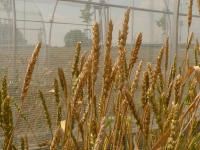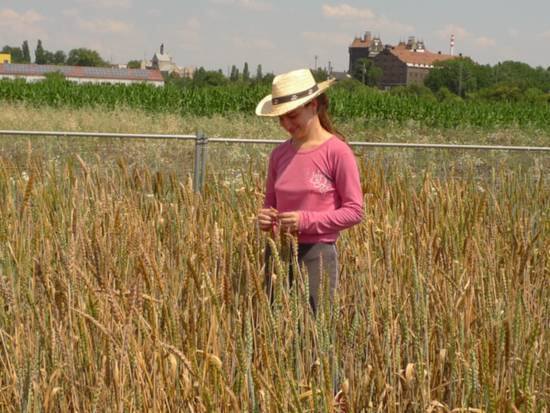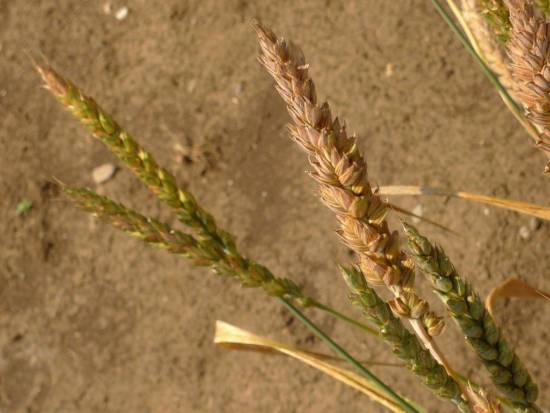Last step before full genome sequence
The International Wheat Genome Sequencing Consortium (IWGSC) published today in the international journal Science a draft sequence of the bread wheat genome. The chromosome-based draft provides new insight into the structure, organization, and evolution of the large, complex genome of the world’s most widely grown cereal crop. The genetic blueprint of the wheat genome was obtained using the chromosome-based strategy developed by research team of Jaroslav Doležel, Professor at the Institute of Experimental Botany AS CR.
The genetic blueprint is an invaluable resource to plant science researchers and breeders. For
the first time, they have at their disposal a set of tools enabling them to rapidly locate specific
genes on individual wheat chromosomes throughout the genome. Jorge Dubcovsky, Professor at the
University of California Davis, USA, says that these results “have been a fantastic resource for
our laboratory. The development of genome specific primers, which used to take several weeks of
work, can now be done in hours. Mapping of any sequence to the specific chromosome arm can now be
done
in silico in minutes. In addition to the acceleration of day to day work in wheat genetics,
this resource has made possible analyses and discoveries at the genome level that were not possible
before.“
The draft sequence is a major landmark towards obtaining a complete reference sequence of the
hexaploid bread wheat genome, the ultimate aim of the International Wheat Genome Sequencing
Consortium. In the same issue of
Science, another article presents the reference sequence for the first of the 21 wheat
chromosomes. The team of Professor Doležel participated also on this project, which was led by The
French National Institute for Agricultural Research. The reference sequence of the largest wheat
chromosome 3B, with the size equivalent to one third of the human genome, establishes a proof of
concept for Doležel’s chromosome-based strategy and a template for sequencing the remaining
chromosomes. As of today, researchers in the IWGSC estimate that the full genome sequence will be
available within three years.
“With the draft gene sequence for each of the bread wheat chromosome and the first reference
sequence of chromosome 3B, we have reached a great milestone in our roadmap,” said Catherine
Feuillet, IWGSC co-chair. “We know now the way forward to obtain a reference sequence for the 20
remaining chromosomes and we hopefully will be able to find the resources to achieve this in the
next three years.”
The team of Professor Jaroslav Doležel developed the chromosome-based strategy to unlock the
complex genome of wheat, which is about six times larger the human genome. The team established a
unique set of tools for purification of individual chromosomes and they produce chromosome-specific
molecular resources for members of IWGSC. This facilitates sequencing the wheat genome following
the chromosome by chromosome strategy. Thanks to this, the Czech scientists participate on
sequencing all 21 chromosomes of wheat. „Both publications and the impact these advances makes are
a terrific reward for many years of hard and systematic work of our team and a great motivation to
continue. We are responsible for sequencing three chromosomes and collaborate with leading
laboratories in USA, France, Germany and Japan, among other. At the same time, we have been using
the new knowledge and tools to clone important wheat genes,“ said Jaroslav Doležel.
With a chromosome-based full sequence in hand, plant breeders will have high quality tools at
their disposal to accelerate breeding programs and to identify how genes control complex traits
such as yield, grain quality, disease, pest resistance, or abiotic stress tolerance. They will be
able to produce a new generation of wheat varieties with higher yields and improved sustainability
to meet the demands of a growing world population in a changing environment.
The draft sequence is already providing new insights into the history and evolution of the
wheat genome and genes involved in grain development, as exemplified in two additional publications
appearing in the same issue of
Science.
Wheat is a major dietary component for many populations across the world. Grown on more land
than any other crop, more than 215 million hectares of wheat are harvested annually to generate a
world production of almost 700 million tons, making it the third most produced cereal after maize
and rice. It is the leading source of vegetable protein in human food, having a higher protein
content than either maize or rice. The wheat plant is highly versatile due to its ability to grow
in a wide range of environments. Wheat grain is easily stored and can be converted readily into
flour for making numerous varieties of high quality edible food.
About the IWGSC:
The IWGSC, with more than 1,000 members in 57 countries, is an international, collaborative
consortium, established in 2005 by a group of wheat growers, plant scientists, and public and
private breeders. The goal of the IWGSC is to make a high quality genome sequence of bread wheat
publicly available, in order to lay a foundation for basic research that will enable breeders to
develop improved varieties.
More information can be found at
http://olomouc.ueb.cas.cz and
www.wheatgenome.org
Contact:
|
Miroslava Kaňková, MSc.
Academy of Sciences of the Czech Republic
Media Communication Division
Národní 3
CZ-117 20 Praha 1
Czech Republic
Tel.: (+420) 221 403 574
Cell: (+420) 606 887 488
e-mail:
kankova@kav.cas.cz
|
Professor Jaroslav Doležel
Institute of Experimental Botany AS CR
Centre of the Region Haná for Biotechnological and Agricultural Research
Šlechtitelů 31
CZ-783 71 Olomouc
Czech Republic
Tel.: (+420) 585 238 701 (703)
Cell: (+420) 774 595 154
E-mail:
dolezel@ueb.cas.cz
|
17 Jul 2014









